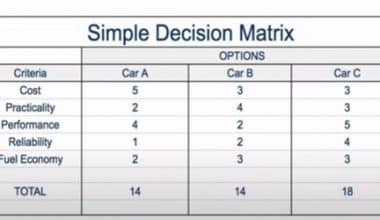Assets vs liabilities make up the two halves of your balance sheet. Liabilities are the amounts owed by a corporation, while assets are the resources that it holds. Learn the difference by reading on. In business, one of the quickest ways to fail is to lose track of the company’s balance sheet. Debt payments, excess inventory, and client receivables are all things you should be aware of. Recognizing the difference between assets vs liabilities is the first step in analyzing a balance sheet. Read on to see the examples of assets vs liabilities. We also added the differences between assets vs liabilities vs equity for you to get a better understanding of them. Enjoy the ride!
What Are Assets?
Any resource that increases a company’s worth is considered an asset. Also, the value of a corporation rises in direct proportion to the quantity and quality of its assets. If you want to see your firm prosper, you need to make it a priority to amass assets and keep tabs on them. Keeping track of transactions and figures is also second nature for accountants. Also, employee compensation is a business expense, not a capital expenditure. The income statement is where any spending, such as purchases, will show up. However, capitalized items are recorded as assets in the financial statements.
Small, one-time purchases are often written off as operating expenses, but larger, longer-term investments are usually capitalized. Credit sales are another way to generate assets. Accounts receivable (AR) are an asset on the balance sheet and are created when goods or services are sold on credit. Also, if you prepay your rent for an entire year, that would be an asset on your balance sheet.
What Are the Types of Assets?
The following are the types of assets:
#1. Current Assets of Immediate Value
These are some examples of liquid assets that can be used right away:
- Cash
- Inventory
- Accounts receivable
#2. Non-current or Fixed Assets That Do Not Have Immediate Value
Fixed assets that do not produce an immediate profit are examples of non-current assets, here are some examples:
- Real estate
- Equipment
- Vehicles
Furthermore, these items are classified as either “tangible” or “intangible.” Equipment and automobiles are also examples of tangible assets. Things like legal contracts that grant you the ability to legally sell your goods or services are examples of intangible assets.
#3. Contra
Accumulated depreciation and provision for doubtful accounts are two examples of significant counter assets. Although contra accounts are assets in and of themselves, they lower the net value of the primary asset to which they pertain. Depreciation that has already been applied to an asset is known as its “accumulated depreciation.” Accounts receivable that have been written off due to a lack of confidence in the collection are included in the allowance for doubtful accounts.
#4. Intangible
If you just used accounting principles, the value of a company would be equal to the market value of its assets minus its total debt. However, reality does not function that way. In many cases, a company’s worth exceeds the sum of its parts because of intangible factors like the strength of its brand name or, gasp, the quality of its workforce and corporate culture. When a firm pays more than the value of its net assets for another, the difference is recorded as goodwill on the balance sheet of the acquiring company. In the case of patents and other similar assets, the expense of obtaining the patent is recorded as an asset on the balance sheet. The value of a patent is spread out across the number of years it will remain in effect.
How Are Assets Tracked?
The assets possessed by a corporation are detailed in the annual report that is prepared at the end of each fiscal year. On a balance sheet, they are totaled up based on how much they have cost in the past. If you want to know how much your firm is worth or how much you owe in taxes, you need to know how much your assets are worth.
What Are Liabilities?
Any obligation incurred by your company is considered a liability. Obtaining a loan to fund your company’s purchase of new machinery is an example of a liability. Liabilities reduce a company’s worth, so it’s in the best interest of its owners to keep them to a minimum.
What Are the Two Major Types of Liabilities?
Liabilities come in two primary forms:
#1. Short-Term Liabilities, Which Are Paid off within a Year
Payables to suppliers and prepaid costs make up the bulk of the company’s current obligations. When you buy something on account, you create an account payable. However, payment is typically due 30 days after the invoice date under standard terms. It’s possible that APs will take longer than 30 days to be paid off because some construction companies only pay when they’re paid.
Other obligations on the balance sheet that have not yet been formally invoiced are referred to as “accruals.” Accrued liabilities include things like employee tax withholding, which is deducted from paychecks weekly but paid to the government only once every three months. All of the workers’ sick and vacation time balances will be calculated based on their present balances and their pay rates.
Examples of current liabilities include:
- Employee wages
- Vendor payments
#2. Long-Term Liabilities, Which Are Paid over a Longer Period
Term loans from banks are typically the only form of long-term liability for small enterprises. Also, loan terms could range from three years for a trailer to twenty years for a structure.
Examples of long-term liabilities include:
- Long-term loans
- Employee benefits
What Is the Distinction between Assets vs Liabilities?
Although they share a similar tone, liabilities vs assets serve quite different purposes. Debts, or liabilities, are what your business owes, while assets are what it must pay regularly. Loans are liabilities, while utility payments are assets.
Difference between Assets vs Liabilities
The key difference between assets vs liabilities is that the former increase a company’s worth while the latter reduces it. You may also calculate your company’s worth and financial health by adding up all of your assets and subtracting all of your liabilities. Therefore, in order to maximize profits, firms should constantly be on the lookout for new assets and ways to lower their liabilities.
However, the value of a company’s assets vs liabilities is always shifting as it operates. Understanding the distinction between assets vs liabilities can also help you keep an eye on your finances and prevent any unfavorable swings in the ratio between your liabilities vs assets. The following are the difference between assets vs liabilities:
#1. Value of Business
Companies have greater worth than their obligations since they have more assets. Companies normally sum up the worth of all their assets and remove their liabilities to calculate the value of the firm and its financial position.
#2. Credit and Debit
Liabilities are increased and credited to the company’s account, while decreases in assets are debited. When liabilities rise, the company records a credit, and when they fall, a debit.
#3. The Flow of Cash
A company’s assets are a source of revenue that can be used to cover everyday expenses and contingencies. On the other hand, obligations necessitate payment, which reduces available capital for use in the business.
#4. Depreciation
When it comes to assets, the fixed ones have depreciating value, meaning they steadily lose value due to wear and tear and eventually lose their value when they wear out totally. Since the corporation must pay off its liabilities within a set time frame, they do not depreciate over time.
#5. Business Expansion
A firm acquires assets to develop the business and boost its worth. Conversely, it incurs debt in order to finance the purchase of additional assets that will one day be used to settle the liabilities.
#6. Method of Calculation
Assets vs liabilities are calculated differently by financial experts, which is still another distinction between the two. Companies calculate their assets by adding their liabilities to their equity, whereas they calculate their liabilities by taking their equity away.
Assets vs Liabilities Examples
Here are a couple of examples that illustrate the interplay between assets vs liabilities.
#1. Comparing Stock and Bills Due
Accounts payable is often thought of in relation to stock for many businesses, notably those in the retail sector. Stock is purchased on credit, and the balance is due upon sale or within 30-60 days. Both inventory and payables are increased in the first transaction, but thereafter they remain separate, and it is up to you to decide when and how to sell the inventory and settle the payables.
#2. Real Estate vs. Long-Term Debt
Most construction projects rely on permanent financing. The reason is, it just makes good logic. Because you can spread out into a larger location without breaking the bank, you can expand your business. The two are separated once the first deal is struck, just as in the first instance, and the loan repayments are generally scheduled to occur automatically. The loan will be repaid in full if the building is sold before the loan term ends.
Assets vs Liabilities vs Equity
Having learned the distinction between assets vs liabilities, you should now focus on the role that equity plays in the accounting process. Justice is the :
- The money is put into a corporation by its founders or shareholders.
- Market capitalization
- The connection between a company’s assets vs liabilities is not complete without equity.
Assets on a balance sheet equal Liabilities plus Equity. If there is a discrepancy, it must be determined and corrected. The equation can be seen in a number of different ways:
- Equity = Assets – Liabilities
- Assets = Liabilities + Equity
- Liabilities = Assets – Equity
The accounting formula reveals to business owners and their accountants whether or not the company is funded by its own resources or by taking on debt. Double-entry bookkeeping systems are the only ones that should be using the accounting equation. The impact of equity is the same on both sides of any given equation. A company can easily determine the third number if it only needs to consider two variables (such as equity and assets).
How to Determine Equity
Here is the formula you can use to determine equity:
Assets − Liabilities = Equity
The amount of equity a company has can be calculated in three easy steps.
#1. Identify the Company’s Holdings
The first stage is to determine the worth of the company’s assets by tallying up all of the sources of revenue and factors into the company’s profit. These things also contain all the precious items the company has.
#2. Determine the Company’s Liabilities
When the company’s total assets have been calculated, the following step is to calculate its total liabilities. All mortgages, salaries, and rents owed by tenants and landlords are included in this category of obligations.
#3. Determine the Total Equity
Equity is the remaining balance after all debts have been paid off and all assets have been counted. The number on the left is the equity.
What Are 10 Examples of Assets?
The following are examples of assets:
- Cash and cash equivalents.
- Accounts receivable (AR)
- Marketable securities.
- Trademarks.
- Patents.
- Product designs.
- Distribution rights.
- Buildings.
Examples of Liabilities
The following are examples of liabilities:
- Accounts payable
- Payroll due
- Payroll taxes
- Accrued expenses
- Short-term notes payable
- Income taxes
- Interest payable
- Accrued interest
- Utilities
- Rental fees
- Other short-term debts.
What Are the Four Main Types of Assets?
The following are the 4 main types of assets:
- Cash
- Fixed income
- Equities
- Property
Are Houses an Asset?
Even if you still owe some money on your mortgage, it is still considered an asset. Your home’s value can also be determined by looking at recent sales prices in the area, its taxable value, or the purchase price you paid.
Final Thoughts
You can’t run a company successfully without first understanding financial accounts, which is why learning to read them is so important. Therefore, knowing the difference between assets vs liabilities will surely do you more good too. You’ll gain a clearer picture of the company’s overall performance and be better able to prioritize equity claims on assets over liabilities as time goes on.
Related Articles
- IT ASSET MANAGEMENT: Meaning, example, systems & software(Opens in a new browser tab)
- LLC VS INC: What is the Difference & Which Is Best
- EXPENSES LIABILITIES: Definition, Types, Examples & Differences
- LLC VS LLP: Key Difference, Similarities & All You Should Know
- WHAT ARE ASSETS AND LIABILITIES: Definition, Differences and Examples






